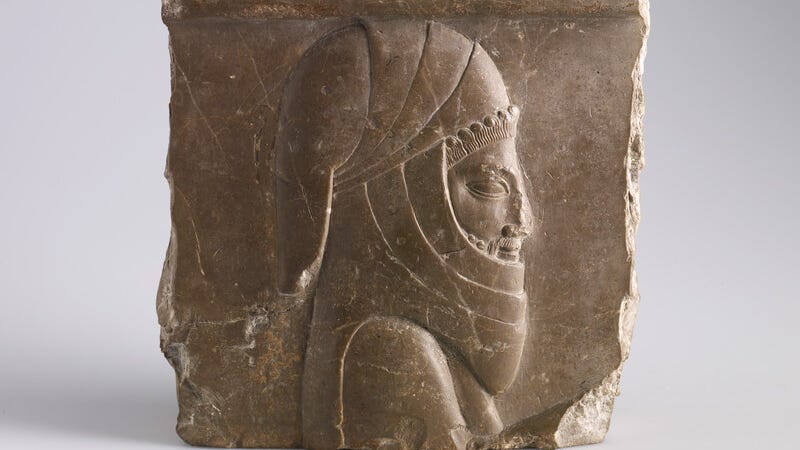Relief of a gift bearer, 490–470 BC. Bituminous limestone, 8 1/8 x 7 1/2 x 4 in (20.6 x 19.1 x 10.2 cm); 7 1/2 x 7 3/4 x 3 1/2 in (19.1 x 19.7 x 8.9 cm) steel mount. Fine Arts Museums of San Francisco, gift of Lisa Sardegna, Albert P. Wagner Bequest Fund, William A. Stimson, Friends of Ian White Endowment Income Fund, Unrestricted Art Acquisition Endowment Fund, Volunteer Council Acquisition Fund, Ancient Art Trust Fund and Auction Proceeds, Mrs. John N. Rosekrans, Jr., Sande Schlumberger, Endowment Fund in Honor of Francesca and Thomas Carr Howe, Walter H. and Phyllis J. Shorenstein Foundation Fund, Tish and James Brown and various Tribute Funds, 2008.1
About Ancient art
Since the de Young and Legion of Honor were established, ancient art has been an integral part of our museums. Antiquities were considered essential to museums in the late 19th and early 20th century, and both M. H. de Young, founder of the de Young, and Alma de Bretteville Spreckels, founder of the Legion of Honor, furnished their institutions with diverse objects from antiquity. The works they brought to the museums and those added over the years represent a broad range of time and geography across the ancient Mediterranean basin—primarily Egypt, the Near East, Central Asia, Greece and its southern Italian colonies, the Aegean Islands, Etruria, and Rome. One of the earliest and largest gifts of ancient art was a group of objects received by Spreckels from Elisabeth, the Queen of Greece. Thanks to the generous donations of the Cowles family, Islamic ceramics are also part of this collection.
The ancient art collection is displayed on the Legion's lower level in the Hall of Antiquities. The objects on view include sculptures, figurines, vessels, jewelry, and carved reliefs made of diverse materials, such as marble and other stones, bronze, gold, ivory, terracotta, wood, and glass. Rare and important works from early civilizations, spanning more than 5,000 years, provide an understanding of the origins of Western Art and the procession of cultures through the ages. Notable sculptures from Egypt include an exquisite 4,000-year-old carved wood figure of Seneb, a Middle Kingdom official from Dynasty 12 (ca. 1897-1839 BC); a granodiorite torso of a god from the end of the reign of Amenhotep III (1363-1353 BBC); a carved cedar coffin with an inlaid hieroglyphic inscription from Dynasty 30 (380-343 BC); and a carved royal limestone relief of Ptolemy I Soter making an offering (305-282 BC). On display from the Near East are an Assyrian stone relief from the palace of Ashernasirpal II (883-859 BC), carved ivories from Fort Shalmaneser in Nimrud (8th and 7th century BC), an Achaemenid Persian stone relief from the palace of Xerxes I (490-470 BC), and a Sasanian silver-gilt bowl with niello inlay from the 6th or 7th century AD. The classical collection includes three marble Cycladic figures from the mid-third-millennium BC; a display of Attic ware vases; a monumental 4th-century BC red-figure volute krater from South Italy, skillfully painted with a scene from Homer's Iliad by the Baltimore Painter; a marble cult statue of Asklepios, god of medicine; and many other ancient treasures.
The collection is supported in part by the Ancient Art Council, which offers a wide variety of programs focusing on the ancient world.
